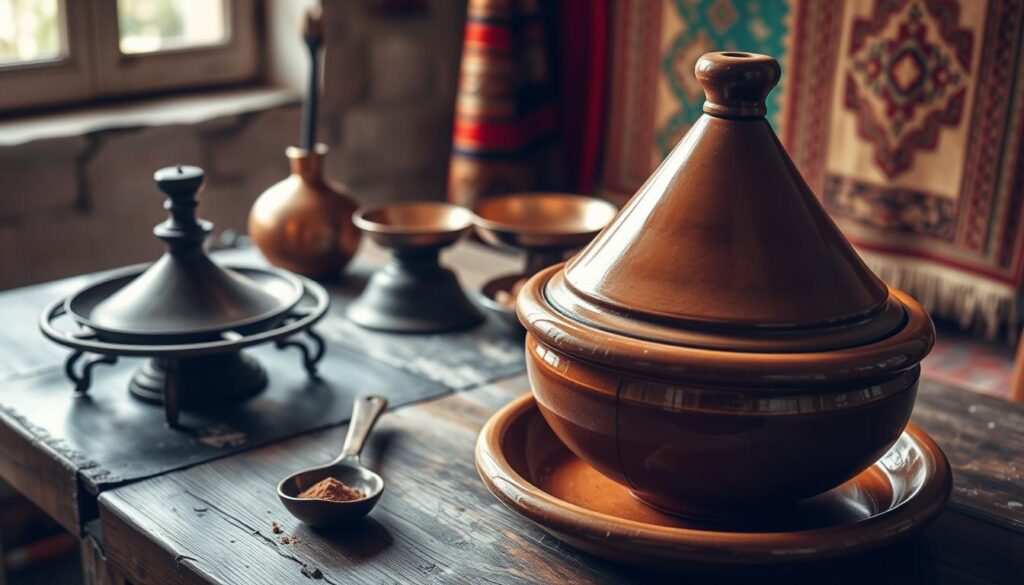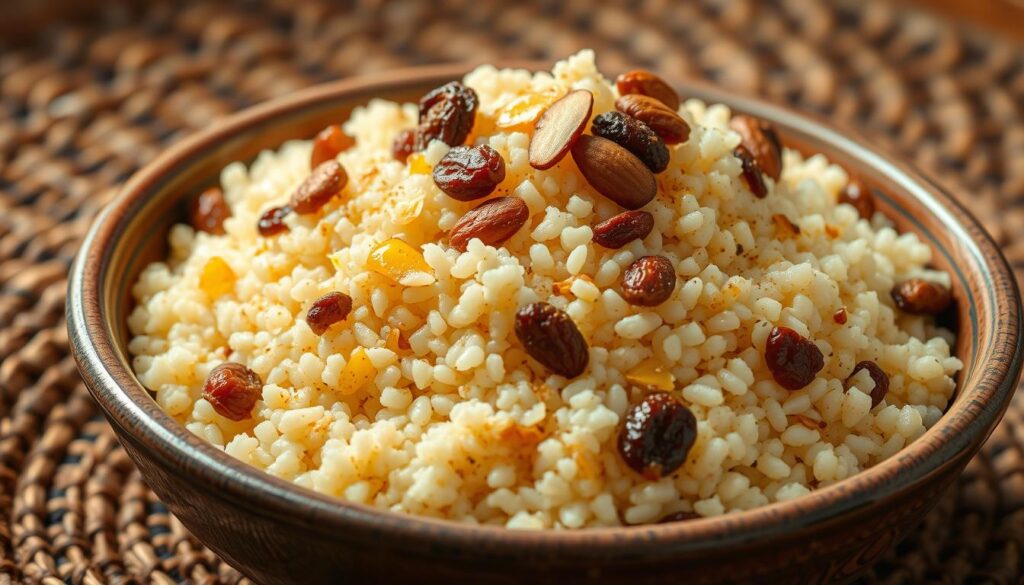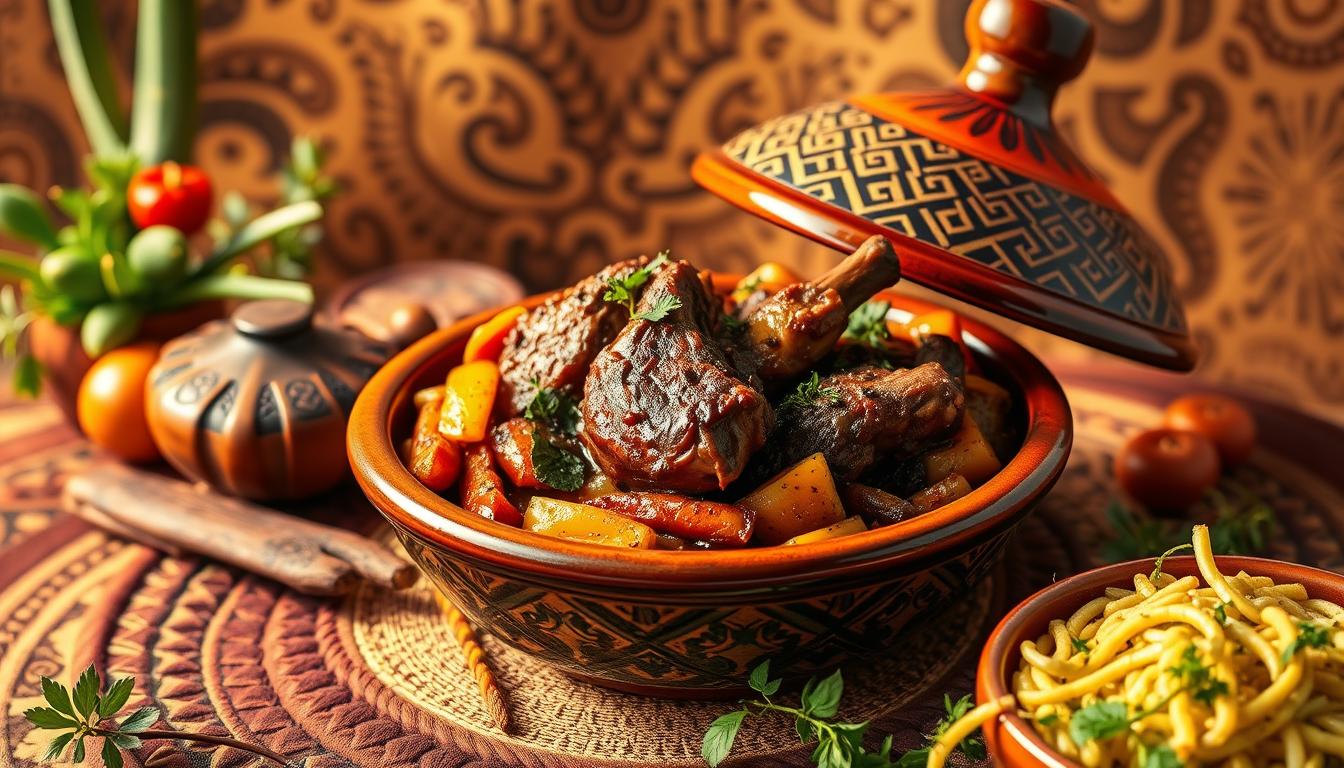Have you ever wondered what makes Moroccan cuisine so rich and aromatic? The answer lies in its rich cultural heritage and the blend of North African flavors.
Embark on a culinary journey to Morocco with our authentic tagine meal that embodies the essence of this beautiful country. This slow-cooked lamb stew is not only a staple of Moroccan cooking but also a reflection of its rich history.
Our traditional lamb tagine recipe is designed to guide you through the preparation of this iconic dish, ensuring a memorable culinary experience.
Key Takeaways
- Discover the rich flavors of Moroccan cuisine
- Learn to prepare an authentic tagine meal
- Explore the cultural significance of slow-cooked lamb stew
- Follow a simple and enjoyable recipe
- Experience the warmth of North African hospitality
What is a Lamb Tagine?
In the heart of North African cuisine lies the lamb tagine, a traditional Moroccan stew known for its aromatic spices and tender lamb. This iconic dish is named after the earthenware pot in which it is cooked, a tagine, which is an integral part of its identity and cooking method.
The Origins of Tagine Cooking
Tagine cooking has its roots deep in the history of North Africa, particularly in Morocco, where it has been a staple for centuries. The method of slow-cooking meat and vegetables in a clay pot over low heat is not only a testament to the resourcefulness of traditional Moroccan cooking but also a reflection of the rich cultural heritage of the region.
The traditional tagine pot is designed to allow the steam to rise and then condense back into the dish, creating a moist and flavorful stew. This unique cooking vessel is a key element in the preparation of a tagine.
Traditional Ingredients Used
The ingredients used in a traditional lamb tagine are simple yet flavorful. They typically include lamb, onions, garlic, ginger, and a variety of spices. Dried fruits such as prunes or apricots are also commonly added to give the dish a sweet and tangy flavor.
- Lamb or other meats (beef, chicken)
- Aromatics like onions, garlic, and ginger
- A blend of spices including cumin, coriander, and cinnamon
- Dried fruits for added sweetness
The Role of Spices in Tagine
Spices play a crucial role in the flavor profile of a lamb tagine. The blend of spices, known as ras el hanout, which translates to “head of the shop,” is a mix of the finest spices available and can vary greatly from one cook to another.
“The art of making tagine is not just about the ingredients; it’s about the love and care that goes into slow-cooking the stew, allowing the flavors to meld together beautifully.”
The spices not only add depth and warmth to the dish but also contribute to its aromatic qualities, making the lamb tagine a truly sensory experience.
Essential Equipment for Making Tagine
For those eager to try their hand at easy tagine cooking, selecting the right equipment is the first step. The traditional tagine pot is at the heart of this cooking process.
Choosing the Right Tagine Pot
The traditional tagine pot is made from clay and is designed with a unique conical lid that allows steam to condense and drop back into the dish, ensuring that flavors are retained. When choosing a tagine pot, look for one that is:
- Made from unglazed clay for authentic cooking
- Durable and resistant to cracking
- Properly sized for the number of servings you plan to make
A good quality tagine pot is an investment in your cooking journey. As noted by culinary experts, “The tagine pot is not just a cooking vessel; it’s a part of the cooking process that enhances the flavors and textures of the dish.”
“The tagine is a cooking vessel that has been used for centuries in Moroccan cuisine, and its design is crucial to the slow cooking process that defines tagine dishes.”
Alternative Cooking Methods
Not everyone has access to a traditional tagine pot, but that doesn’t mean you can’t enjoy easy tagine cooking. Alternative cooking methods and vessels can be used to achieve similar results.
| Cooking Method | Vessel | Benefits |
|---|---|---|
| Slow Cooking | Crockpot or Slow Cooker | Convenient and hands-off |
| Oven Cooking | Dutch Oven | Even heat distribution |
| Stovetop Cooking | Heavy-bottomed Pot | Control over heat |

Each of these methods can produce delicious tagine dishes, and the choice often comes down to personal preference and the equipment you have available.
Ingredients for the Traditional Lamb Tagine
Aromatic lamb and vegetable tagine is a classic Moroccan dish that combines tender lamb with a variety of spices and vegetables. The ingredients used in a traditional lamb tagine are crucial to its flavor and aroma.
Key Ingredients for Flavor
The foundation of a delicious lamb tagine lies in its key ingredients. These include:
- Lamb: The main protein component, typically lamb shoulder or lamb neck, which becomes tender with slow cooking.
- Onions: Provide a sweet and savory flavor base.
- Garlic: Adds depth and richness to the dish.
- Ginger: Fresh ginger contributes a warm, spicy flavor.
- Spices: A blend of spices including cumin, coriander, cinnamon, and turmeric gives the tagine its characteristic flavor.
The combination of these ingredients creates a rich and aromatic sauce. The spices are essential to the authentic flavor of the tagine.
| Ingredient | Quantity | Purpose |
|---|---|---|
| Lamb | 1 kg | Main protein |
| Onions | 2 large | Flavor base |
| Garlic | 3 cloves | Adds depth |
| Ginger | 2 inches | Warm, spicy flavor |
| Spices | 1 tablespoon each | Characteristic flavor |
Optional Ingredients for Variation
While the key ingredients provide the core flavor, optional ingredients can be added to create variations of the traditional lamb tagine. These include:
- Dried Fruits: Such as prunes or apricots, which add sweetness.
- Nuts: Almonds or other nuts can be added for texture.
- Preserved Lemons: Add a salty, tangy flavor.
These optional ingredients allow for creativity and personalization of the traditional recipe. By incorporating one or more of these ingredients, you can create a unique version of the lamb tagine that suits your taste preferences.
Preparing the Lamb for Cooking
To achieve tender and flavorful lamb, proper preparation is essential. Preparing the lamb is a critical step in making a delicious slow-cooked lamb dish. The process involves marinating the lamb to enhance its flavor and cutting it into appropriate sizes to ensure even cooking.
Marinating the Lamb
Marinating the lamb is a crucial step that adds depth and complexity to the final dish. A mixture of spices, herbs, and sometimes yogurt or lemon juice is used to marinate the lamb. The acidity helps to break down the proteins, making the lamb more tender. For a traditional Moroccan tagine, a marinade that includes ingredients like cumin, coriander, ginger, and garlic is recommended.
Tip: Allow the lamb to marinate for at least a few hours or overnight for the best results. This allows the flavors to penetrate deeper into the meat, resulting in a more flavorful slow-cooked lamb dish.
Cutting the Lamb Properly
Cutting the lamb into the right size is vital for even cooking. For a tagine, it’s common to cut the lamb into bite-sized pieces. This ensures that the lamb cooks uniformly and is tender by the time it’s done. The size of the pieces can vary depending on personal preference, but generally, smaller pieces are recommended for a slow-cooked lamb dish.
- Cut against the grain to reduce chewiness.
- Ensure all pieces are roughly the same size for even cooking.
- Remove any excess fat to prevent the dish from becoming too greasy.
How to Prepare the Vegetables
To create an authentic Moroccan lamb tagine, selecting and preparing the right vegetables is essential. Vegetables add texture, flavor, and nutrients to the dish, making it a hearty and satisfying meal.
Choosing the Right Vegetables
For a traditional Moroccan lamb stew, you can choose from a variety of vegetables. Common options include carrots, potatoes, zucchini, and bell peppers. You can also add other vegetables like onions, garlic, and tomatoes to enhance the flavor.
Carrots and potatoes are popular choices because they hold their shape well during the slow cooking process. Zucchini and bell peppers add a burst of color and flavor to the dish.
Prepping Vegetables for Tagine
Once you’ve chosen your vegetables, it’s time to prep them. Start by washing and peeling the vegetables, then chop them into bite-sized pieces. For root vegetables like carrots and potatoes, you can cut them into larger chunks, while vegetables like zucchini and bell peppers can be sliced or diced.
It’s also a good idea to prepare any aromatics, such as onions and garlic, by chopping them finely. This will help to release their flavors during the cooking process.
Cooking Techniques for Lamb Tagine
To create an authentic traditional lamb tagine, one must understand the cooking techniques that make this dish so special. The art of cooking a tagine is rooted in its ability to layer flavors and achieve tender meat through slow cooking.
Layering Flavors with Searing
The first step in making a rich and flavorful tagine is searing the lamb. This process involves quickly cooking the lamb pieces in a hot pan to create a crust on the outside. As Chef Fatima Zahra, a renowned Moroccan chef, once said, “Searing the lamb is like awakening its flavors; it’s the first step to a deep and satisfying taste.” Searing not only enhances the flavor but also helps to lock in the juices, making the lamb more tender.

Slow Cooking for Tenderness
After searing the lamb, the next crucial step is slow cooking. This involves cooking the lamb over low heat for an extended period, allowing the meat to become tender and the flavors to meld together. Slow cooking is essential for developing the characteristic tender texture of a traditional lamb tagine. As the tagine cooks, the flavors of the spices, herbs, and lamb blend together, creating a rich and aromatic sauce.
The slow cooking process can be achieved using a traditional clay tagine pot or alternative cooking methods such as a slow cooker or Dutch oven. Regardless of the method, the key is to maintain a low and consistent heat to ensure the lamb cooks slowly and evenly.
By combining the techniques of searing and slow cooking, you can create a traditional lamb tagine recipe that is both flavorful and tender. This dish is a testament to the rich culinary heritage of Morocco and is sure to impress anyone who tries it.
Step-by-Step Cooking Instructions
To make this popular tagine recipe a staple in your kitchen, follow our detailed step-by-step cooking instructions. This guide will walk you through the process, ensuring that your lamb tagine turns out flavorful and tender.
Getting Started with the Recipe
Begin by heating a couple of tablespoons of oil in the bottom of your tagine or heavy pot over medium heat. Sear the lamb pieces until they are browned on all sides, then remove them from the pot and set them aside. This step is crucial as it locks in the flavors.
Next, add the chopped onions to the pot and cook until they are softened and lightly browned. Add the minced garlic and cook for another minute, stirring constantly to prevent burning.
Cooking Time and Temperature
Once your vegetables and lamb are prepared, it’s time to start cooking the tagine. Return the lamb to the pot, and add the necessary spices, broth, and any other desired ingredients. Bring the mixture to a simmer.
Reduce the heat to low and let the tagine cook, covered, for about 1.5 to 2 hours, or until the lamb is tender and the flavors have melded together. If you’re using a clay tagine, you can place it over low heat on the stovetop or in a preheated oven at 300°F (150°C).
To ensure the tagine is cooked to perfection, check on it periodically. The cooking time may vary depending on the tenderness of the lamb and the specific cooking method you’re using.
Suggested Side Dishes for Lamb Tagine
To create an authentic Moroccan meal, it’s essential to pair your Lamb Tagine with traditional side dishes. These accompaniments not only complement the flavors of the tagine but also add to the overall dining experience.
The traditional North African cuisine suggests serving Lamb Tagine with either Moroccan Couscous or Fresh Moroccan Bread. Both options are staples in Moroccan cuisine and are known for their ability to soak up the rich, flavorful sauce of the tagine.
Moroccan Couscous
Moroccan Couscous is a classic accompaniment to Lamb Tagine. It’s made from semolina flour and is typically steamed to perfection. The light, fluffy texture of couscous provides a nice contrast to the slow-cooked lamb and vegetables in the tagine.
To prepare Moroccan Couscous, simply steam it according to the package instructions. You can also add some fresh herbs or a squeeze of lemon juice to give it a bit more flavor.

Fresh Moroccan Bread
Another traditional option is serving Lamb Tagine with Fresh Moroccan Bread, also known as Khobz. This crusty bread is perfect for dipping into the tagine’s sauce, making each bite a flavorful experience.
To make Fresh Moroccan Bread, you’ll need flour, yeast, water, and salt. The dough is typically allowed to rise before being shaped into rounds and baked until golden brown.
Tips for Serving Traditional Lamb Tagine
An authentic tagine meal is not just about the taste; it’s also about the presentation. Serving your lamb tagine with care and attention to detail can elevate the dining experience, making it a memorable occasion for your guests.
Presentation Ideas
When it comes to presenting your tagine, the possibilities are endless. You can serve it directly from the tagine pot, garnished with fresh herbs and a sprinkle of spices. Alternatively, you can transfer it to a decorative serving dish to add a touch of elegance to your table setting.
Consider adding some colorful elements around the dish, such as:
- Fresh parsley or cilantro
- Sliced lemons or preserved lemons
- Moroccan olives
Garnishing with Fresh Herbs
Garnishing your lamb tagine with fresh herbs not only adds a pop of color but also enhances the aroma and flavor. Some popular herbs used for garnishing include parsley, cilantro, and mint.
Here are some tips for garnishing:
| Herb | Usage | Flavor Profile |
|---|---|---|
| Parsley | Chopped, sprinkled on top | Fresh, green |
| Cilantro | Chopped, mixed with spices | Citrusy, earthy |
| Mint | Leaves, used sparingly | Cooling, refreshing |
By paying attention to the presentation and garnishing of your lamb tagine, you can create an authentic tagine meal that delights both the eyes and the palate, making your easy tagine cooking efforts truly shine.
Storing Leftovers and Reheating
After savoring your delicious slow-cooked lamb dish, you might have leftovers. Proper storage and reheating techniques are crucial to maintaining the flavor and tenderness of your aromatic lamb and vegetable tagine.
Preserving the Flavors
To store leftovers, cool the tagine to room temperature, then transfer it to an airtight container. Refrigerate or freeze it promptly. When refrigerating, consume within three to four days. If frozen, the tagine can be stored for up to three months.
Reheating for Enjoyment
When reheating, gently warm the tagine over low heat on the stovetop or in the microwave, ensuring it reaches a safe internal temperature. Adding a splash of water or broth can help maintain moisture. This careful reheating will help preserve the dish’s original flavors, allowing you to enjoy your slow-cooked lamb dish again.


